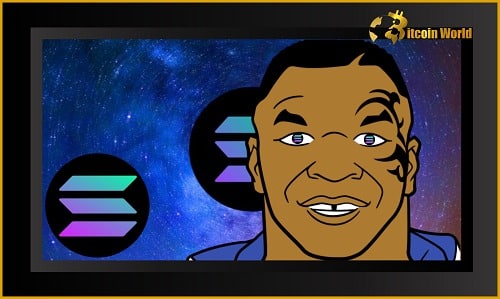The crypto world is buzzing! Mike Tyson, the legendary boxer, recently declared his allegiance to Solana, a blockchain often touted as an “Ethereum killer.” This endorsement has reignited the ongoing debate: Can Solana truly challenge Ethereum’s dominance?
Tyson’s Tweet: A Solana Stamp of Approval
Tyson’s tweet, featuring a Catalina Whale NFT on the Solana blockchain, sent ripples through the crypto community. But this isn’t his first foray into the crypto space. He previously sought advice from his Twitter followers on choosing between Ethereum and Bitcoin. This latest move, however, signals a stronger interest in Solana’s potential.
He has also started promoting Dream (DREAM), a coin built on Ethereum. He says that it could “revolutionize” the sector and help people with mental health issues.
Solana vs. Ethereum: The Key Differences
The rivalry between Solana and Ethereum is intensifying, with both platforms vying for dominance in the NFT and DeFi spaces. Here’s a breakdown of their key differences:
| Feature | Ethereum | Solana |
|---|---|---|
| Consensus Mechanism | Proof-of-Work (transitioning to Proof-of-Stake) | Proof-of-History (PoH) & Proof-of-Stake (PoS) |
| Transaction Speed | ~15 transactions per second (TPS) | ~50,000 TPS |
| Transaction Fees | High (can be very high during peak times) | Low (typically fractions of a cent) |
| Scalability | Limited (currently being addressed with Ethereum 2.0) | High |
| Decentralization | More decentralized | Less decentralized (due to higher hardware requirements for validators) |
Why Solana’s Surge?
Solana’s appeal lies in its speed and low transaction costs, making it an attractive alternative for users and developers seeking faster and more affordable transactions. JPMorgan and Bank of America have even suggested that Solana is gaining ground on Ethereum, potentially eroding its market share.
- Speed: Solana’s innovative Proof-of-History consensus mechanism allows for significantly faster transaction processing.
- Low Fees: Lower transaction fees make Solana more accessible for everyday users and microtransactions.
- Growing Ecosystem: Solana’s ecosystem is rapidly expanding, with a growing number of NFT projects, DeFi applications, and other decentralized services.
The Challenges Facing Solana
Despite its advantages, Solana has faced its share of challenges, particularly concerning network stability. Outages and technical issues have raised concerns about its readiness for widespread adoption.
- Network Outages: Solana has experienced several network outages, raising questions about its reliability.
- Centralization Concerns: The higher hardware requirements for Solana validators have led to concerns about potential centralization.
What Does This Mean for the Future?
The competition between Solana and Ethereum is ultimately beneficial for the entire crypto ecosystem. It drives innovation, encourages developers to build better solutions, and provides users with more choices.
While Solana offers advantages in terms of speed and cost, Ethereum remains the dominant platform with a larger ecosystem and a more established track record. The future will likely see both platforms coexisting and catering to different needs and use cases.

Related Posts – Ex-SEC Chair, Jay Clayton Believes Cryptocurrency Industry Is For Long Haul
Disclaimer: The information provided is not trading advice, Bitcoinworld.co.in holds no liability for any investments made based on the information provided on this page. We strongly recommend independent research and/or consultation with a qualified professional before making any investment decisions.


